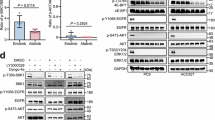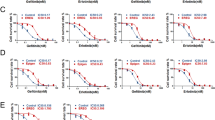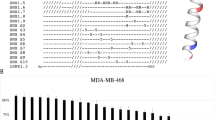Abstract
Over-expression of truncated epidermal growth factor receptor (EGFR) occurs in a variety of malignancies including glioblastoma multiforme, breast and lung cancer. The truncation deletes an extracellular domain and results in constitutive activation of the receptor. NIH3T3 cells were transfected with full length or truncated human EGFR and differences in growth rates in vivo and in vitro analysed. A growth advantage was seen for cells expressing mutant receptor compared to full length EGFR in vivo only. Administration of an anti-mutant EGFR antibody to mice transiently reduced the growth rates of mutant tumours, confirming that the mutant receptor itself was important in this enhanced tumorigenicity. This showed that stimuli present in vivo and not in vitro may be contributing to growth. We therefore analysed the regulation of the angiogenic factor vascular endothelial growth factor (VEGF). Although levels of secreted VEGF did not differ significantly between wild-type and mutant EGFR cell lines when grown in vitro under normoxic conditions, following exposure to 0.1% hypoxia levels of VEGF produced by mutant cells increased 3.5–6.6 fold compared to 2 or less for full length EGFR cells. The fold induction was influenced by experimental conditions, including cell confluence and percentage of fetal bovine serum, but was consistently higher for mutant cell lines. The increase in VEGF under hypoxic conditions was blocked by the addition of PI3 kinase inhibitors, indicating that the latter pathway is important in the hypoxic stress response. Basal levels were not affected. Addition of insulin-like growth factor-1 also increased levels of VEGF under normoxic conditions in the mutant cells and no further increase was seen when added to cells exposed to 0.1% oxygen, indicating that levels of VEGF were already maximally stimulated. These results show that the mutant EGFR interacts with other growth factors and hypoxia to regulate VEGF via a PI3 kinase pathway, and suggests a specific role for anti-mutant EGFR antibodies and PI3 kinase inhibitors as therapy of this specific tumour target. © 2001 Cancer Research Campaign
Similar content being viewed by others
Article PDF
Change history
16 November 2011
This paper was modified 12 months after initial publication to switch to Creative Commons licence terms, as noted at publication
References
Akagi Y, Liu W, Zebrowski B, Xie K and Ellis LM (1998) Regulation of vascular endothelial growth factor expression in human colon cancer by insulin-like growth factor-1. Cancer Res 58: 4008–4014
Antonyak MA, Moscatello DK and Wong AJ (1998) Constitutive activation of c-Jun N-terminal kinase by a mutant epidermal growth factor receptor. J Biol Chem 273: 2817–2822
Arbieser JL, Moses MA, Fernandez CA, Ghiso N, Cao Y, Klauber N, Frank D, Brownlee M, Flynn E, Parangi S and Byers R (1997) Oncogenic H-ras stimulates tumor angiogenesis by two distinct pathways. Proc Natl Acad Sci USA 94: 861–866
Baserga R (1995) The insulin-like growth factor I receptor: a key to tumor growth?. Cancer Res 55: 249–252
De Jong JS, Van Diest PJ, Van der Valk P and Baak JPA (1998) Expression of growth factors, growth-inhibiting factors, and their receptors in invasive breast cancer. II: correlation with proliferation and angiogenesis. J Pathol 184: 53–57
Ekstrand AJ, Sugawa N, James CD and Collins VP (1992) Amplified and rearranged epidermal growth factor receptor genes in human glioblastomas reveal deletions of sequences encoding portions of the N-and/or C-terminal tails. Proc Natl Acad Sci USA 89: 4309–4313
Ekstrand AJ, Longo N, Hamid ML, Olsen JJ, Liu L, Collins VP and James CD (1994) Functional characterization of an EGFR receptor with a truncated extracellular domain expressed in glioblastomas with EGF receptor gene amplification. Oncogene 9: 2312–2320
Ekstrand AJ, Liu L, He J, Hamid ML, Longo N, Collins VP and James CD (1995) Altered subcellular location of an activated and tumor – associated epidermal growth factor receptor. Oncogene 10: 1455–1460
Feldkamp MM, Lau N, Rak J, Kerbel RS and Guha A (1999) Normoxic and hypoxic regulation of vascular endothelial growth factor (VEGF) by astrocytoma cells is mediated by Ras. Int J Cancer 18: 118–124
Fidler IJ and Ellis LM (1994) The implications of angiogenesis to the biology and therapy of cancer metastasis. Cell 79: 185–188
Folkman J (1990) What is the evidence that tumours are angiogenesis dependent?. J Natl Cancer Inst 80: 4–6
Franke TF, Kaplan DR and Cantley LC (1997) P13K: downstream AKTion blocks apoptosis. Cell 88: 435–437
Gerber H-P, McMurtrey A, Kowalski J, Yan M, Keyt BA, Dixit V and Ferrara N (1998) Vascular Endothelial growth factor regulates endothelial cell survival through the phosphatidylinositol 3′kinase/Akt signal transduction pathway. J Biol Chem 273: 30336–30343
Goldman CK, Kim J, Wong W-L, King V, Brock T and Gillespie GY (1993) Epidermal growth factor stimulates vascular endothelial growth factor production by human malignant glioma cells: A model of glioblastoma multiforme pathophysiology. Mol Biol Cell 4: 121–133
Graeber TG, Osmanian C, Jacks T, Housman DE, Koch CJ, Lowe SW and Giaccia AJ (1996) Hypoxia-mediated selection of cells with diminished apoptotic potential in solid tumours. Nature 379: 88–91
Guha A, Feldkamp MM, Lau N, Boss G and Pawson T (1997) Proliferation of human malignant astrocytomas is dependent on Ras activation. Oncogene 15: 2755–2766
Gullick WJ (1991) Prevalence of aberrant expression of the epidermal growth factor receptor in human cancers. Brit Med Bull 47: 87–98
Han Y, Caday CG, Nanda A, Cavenee WK and Huang HJ (1996) Tyrphostin AG 1478 preferentially inhibits human glioma cells expressing truncated rather than wild-type epidermal growth factor receptors. Cancer Res 56: 3859–3861
Harris AL, Nicholson S, Sainsbury R, Wright C and Farndon J (1992) Epidermal growth factor receptor and other oncogenes as prognostic markers. Natl Cancer Inst Monogr 11: 181–187
Hills D, Rowlinson-Busza G and Gullick WJ (1995) Specific targeting of a mutant, activated EGF receptor found in glioblastoma using a monoclonal antibody. Int J Cancer 63: 537–543
Holst LS, Mulder H, Manganiello V, Sundler F, Ahren B, Holm C and Degerman E (1998) Protein kinase B is expressed in pancreatic beta cells and activated upon stimulation with insulin-like growth factor I. Biochem Biophys Res Commun 250: 181–186
Humphrey PA, Wong AJ, Vogelstein B, Zalutsky MR, Fuller GN, Archer GE, Friedman HS, Kwatra MM, Bigner SH and Bigner DD (1990) Anti-synthetic peptide antibody reacting at the fusion junction of deletion-mutant epidermal growth factor receptors in human glioblastoma. Proc Natl Acad Sci USA 87: 4207–4211
Inaba M, Kobayashi T, Tashiro T, Sakurai Y, Ohnishi Y, Ueyama Y and Nomura T (1989) Evaluation of anti tumour activity in a human breast tumour / nude mouse model with a special emphasis on treatment dose. Cancer 64: 1577–1582
Lacal JC and Carnero A (1994) Regulation of ras proteins and their involvement in signal transduction pathways. Oncol Rep 1: 677–693
Levy AP, Levy NS, Wegner S and Goldberg MA (1995) Transcriptional regulation of the rat vascular endothelial growth factor gene by hypoxia. J Biol Chem 270: 13333–13340
Maity A, Pore N, Lee J, Solomon D and Orourke DM (2000) Epidermal growth factor receptor transcriptionally up-regulates vascular endothelial growth factor expression in human glioblastoma cells via a pathway involving phosphatidylinositol 3′-kinase and distinct from that induced by hypoxia. Cancer Res 60: 5879–5886
Maxwell PH, Dachs GU, Gleade JM, Nicholls LG, Harris AL, Stratford IJ, Hankinson O, Pugh CW and Ratcliffe PJ (1997) Hypoxia-inducible factor-1 modulates gene expression in solid tumours and influences both angiogenesis and tumour growth. Proc Natl Acad Sci USA 94: 8104–8109
Mazure NM, Chen EY, Laderoute KB and Giaccia AJ (1997) Induction of vascular endothelial growth factor by hypoxia is modulated by a phosphatidylinositol 3-kinase/Akt signaling pathway in Ha-ras-transformed cells through a hypoxia inducible factor-1 transcriptional element. Blood 90: 3322–3331
Mendelsohn J (1998) Epidermal growth factor receptor inhibition by a monoclonal antibody as anticancer therapy. Clin Cancer Res 3: 2703–2707
Minchenko A, Bauer T, Salceda S and Caro J (1994) Hypoxic stimulation of vascular endothelial growth factor expression in vitro and in vivo. Lab Invest 71: 374–379
Moscatello DK, Holgado-Madruga M, Godwin AK, Ramirez G, Gunn G, Zoltick PW, Biegel JA, Hayes RL and Wong AJ (1995) Frequent expression of a mutant epidermal growth factor receptor in multiple human tumors. Cancer Res 55: 5536–5539
Moscatello DK, Holgado-Madruga M, Emlet DR, Montgomery RB and Wong AJ (1998) Constitutive activation of phosphatidylinositol 3-kinase by a naturally occuring mutant epidermal growth factor receptor. J Biol Chem 273: 200–206
Nishikawa R, Ji X-D, Harmon RC, Lazar CS, Gill GN, Cavenee WK and Huang H-JS (1994) A mutant epidermal growth factor receptor common in human glioma confers enhanced tumorigenicity. Proc Natl Acad Sci USA 91: 7727–7731
Petit AM, Rak J, Hung MC, Rockwell P, Goldstein N, Fendly B and Kerbel RS (1997) Neutralizing antibodies against epidermal growth factor and ErbB-2/neu receptor tyrosine kinases down-regulate vascular endothelial growth factor production by tumour cells in vitro and in vivo: angiogenic implications for signal transduction therapy of solid tumors. Am J Pathol 151: 1523–1530
Rak J, Mitsuhashi Y, Bayko J, Filmus J, Shirasawa S, Sasazuki T and Kerbel RS (1995) Mutantrasoncogenes upregulate VEGF/VPF expression: Implications for induction and inhibition of tumour angiogenesis. Cancer Res 55: 4575–4580
Sacks NPM, Smith K, Norman AP, Greenail M, LeJeune S and Harris AL (1993) Cathepsin D levels in primary breast cancers: relationship with epidermal growth factor receptor, oestrogen receptor and axillary nodal status. Eur J Cancer 29: 426–428
Salomon DS, Brandt R, Ciardiello F and Normanno N (1995) Epidermal growth factor-related peptides and their receptors in human malignancies. Crit Rev Oncol Hematol 19: 183–232
Schmidt M, Reiser P, Hills D, Gullick WJ and Wels W (1998) Expression of an oncogenic mutant EGF receptor markedly increases the sensitivity of cells to an EGFR-receptor-specific antibody toxin. Int J Cancer 75: 878–884
Scott PAE, Gleadle JM, Bicknell R and Harris AL (1998) Role of the hypoxia sensing system, acidity and reproductive hormones in the variability of vascular endothelial growth factor induction in human breast cancer cell lines. Int J Cancer 75: 706–712
Shweiki D, Itin A, Soffer D and Keshet E (1992) Vascular endothelial growth factor induced by hypoxia may mediate hypoxia-initiated angiogenesis. Nature 359: 843–845
Singh P and Rubin N (1993) Insulin like growth factors and binding proteins in colon cancer. Gastroenterology 105: 1218–1237
Takahashi Y, Kitadai Y, Bucana CD, Cleary KR and Ellis CM (1995) Expression of vascular endothelial growth factor and its receptor. KDR correlates with vascularity, metastasis, and proliferation of human colon cancer. Cancer Res 55: 3964–3968
Warren RS, Yuan H, Matli MR, Ferrara N and Donner DB (1996) Induction of vascular endothelial growth factor by insulin-like growth factor 1 in colorectal carcinoma. J Biol Chem 271: 29483–29488
Waterfield MD, Mayes ELV, Stroobant P, Bennet PLP, Young S, Goodfellow PN, Banting GS and Ozanne B (1982) A monoclonal antibody to the human epidermal growth factor receptor. J Cell Biochem 20: 149–161
Whitmarsh AJ and Davis RJ (1996) Transcription factor AP-1 regulation by mitogen-activated protein kinase signal transduction pathways. J Mol Med 74: 589–607
Wikstrand CJ, Hale LP, Batra SK, Hill ML, Humphrey PA, Kurpad SN, McLendon RE, Moscatello D, Pegram CN, Reist CJ, Traweek ST, Wong AJ, Zalutsky MR and Bigner DD (1995) Monoclonal antibodies against EGFRvIII are tumour specific and react with breast and lung carcinomas and malignant gliomas. Cancer Res 55: 3140–3148
Wong AJ, Ruppert JM, Bigner SH, Grzteschik CH, Humphrey PA, Bigner DS and Vogelstein B (1992) Structural alterations of the epidermal growth-factor receptor gene in human gliomas. Proc Natl Acad Sci USA 89: 2965–2969
Zelzer E, Levy Y, Kahana C, Shilo B-Z, Rubinstein M and Cohen B (1998) Insulin induces transcription of target genes through the hypoxia-inducible factor HIF-1α/ARNT. EMBO J 17: 5085–5094
Author information
Authors and Affiliations
Rights and permissions
From twelve months after its original publication, this work is licensed under the Creative Commons Attribution-NonCommercial-Share Alike 3.0 Unported License. To view a copy of this license, visit http://creativecommons.org/licenses/by-nc-sa/3.0/
About this article
Cite this article
Clarke, K., Smith, K., Gullick, W. et al. Mutant epidermal growth factor receptor enhances induction of vascular endothelial growth factor by hypoxia and insulin-like growth factor-1 via a PI3 kinase dependent pathway. Br J Cancer 84, 1322–1329 (2001). https://doi.org/10.1054/bjoc.2001.1805
Received:
Revised:
Accepted:
Published:
Issue date:
DOI: https://doi.org/10.1054/bjoc.2001.1805
Keywords
This article is cited by
-
Anti-angiogenesis Revisited: Combination with Immunotherapy in Solid Tumors
Current Oncology Reports (2021)
-
Deletion of newly described pro-survival molecule Pellino-1 increases oxidative stress, downregulates cIAP2/NF-κB cell survival pathway, reduces angiogenic response, and thereby aggravates tissue function in mouse ischemic models
Basic Research in Cardiology (2020)
-
EGFR wild-type amplification and activation promote invasion and development of glioblastoma independent of angiogenesis
Acta Neuropathologica (2013)
-
Sirolimus inhibits the growth and metastatic progression of hepatocellular carcinoma
Journal of Cancer Research and Clinical Oncology (2009)
-
The Emerging Role of Anti-Angiogenic Therapy for Malignant Glioma†
Current Treatment Options in Oncology (2008)



